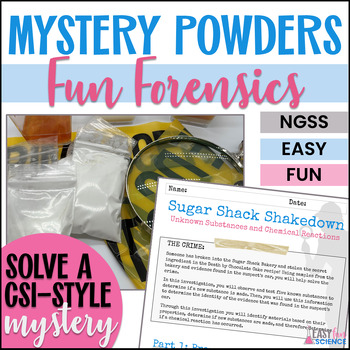Mystery Powders Forensic Science Crime Scene Investigation (CSI) NGSS Activity
- PDF
- Easel Activity
Also included in
- Students LOVE the intrigue of CRIME SCENE INVESTIGATION! This 8-pack of Forensic Science Lesson Plans is the perfect addition to your curriculum, created for upper elementary and middle school students. They will love these not-scary mock crime scene activities! These CSI activities are easy to setPrice $22.00Original Price $32.00Save $10.00
- Looking for fun end of year activities, middle school teacher? Students LOVE the intrigue of Forensic Science CRIME SCENE INVESTIGATION! This 4-pack of Forensic Science Lesson Plans is the perfect addition to your curriculum, created for upper elementary and middle school students. They will love thPrice $12.80Original Price $16.00Save $3.20
Description
In this forensic science activity for middle school students, students will identify unknown substances to solve a "crime." Unlike other forensics activities, this lab will not give your students nightmares!
This activity is perfect for traditional classrooms, enrichment programs/camps, homeschool co-ops, and homeschool students. This is a great alternative to graphic or scary CSI activities. This lab is easy to set up with common materials you can easily find at your local grocery store. Tested and approved by my students - this is a FUN activity that your students will love!
Here is the scenario:
Someone has broken into the Sugar Shack Bakery and stolen the secret ingredient in the Death by Chocolate Cake recipe! Using samples from the bakery and evidence found in the suspect’s car, you will help solve the crime.
In this investigation, students will observe and test five known substances to determine if a new substance is made. Then, they will use this information to determine the identity of the evidence that was found in the suspect’s car.
Through this investigation, students will identify materials based on their properties, determine if new substances are made, and therefore determine if a chemical reaction has occurred.
What will students do in this forensic science activity?
- Read through mock crime report
- Collect evidence from mock crime scene
- Test known substances and record data
- Test unknown substances and compare to known substances to solve the mock crime
What will students learn in this forensic science activity?
- How unknown substances can be compared to known substance to determine their identity
- How to observe physical and chemical changes
- How to identify if a physical or chemical change has taken place
This product includes the following:
- Teacher instructions with and without photos
- Student instructions with and without photos
- Data table
- Comprehension/Analysis questions
This activity supports the following NGSS:
- 5-PS1-3
- 5-PS1-4
- MS-PS1-2
Looking for more Fun Forensics activities? Check out...
- Forensic Science Urinalysis Crime Scene Investigation
- Forensic Science Chromatography Crime Scene Investigation (CSI) Activity
- Forensic Science Fingerprinting Crime Scene Investigation (CSI) Activity
- Halloween Forensic Science Crime Scene Investigation Blood Spatter Activity
- Thanksgiving Forensics CSI DNA Extraction and Fingerprinting Gel Electrophoresis
- Forensic Science Christmas Activity Crime Scene Investigation & Fat Analysis
- Valentine's Day Forensic Science Crime Scene Investigation (CSI) Activity
FUN FORENSICS BUNDLES:
- Fun Forensics Mega Bundle of 4 (Urinalysis, Mystery Powders, Chromatography, Fingerprinting, Halloween, Thanksgiving, Christmas/Holiday, Valentine's Day)
- Fun Forensics Bundle of 4 (Urinalysis, Mystery Powders, Chromatography, Fingerprinting)
- Holiday Crime Scene Investigation Bundle of 4 (Halloween, Thanksgiving, Christmas/Holiday, Valentine's Day)
Check out my blogs and contact me directly at EasyFunScience.com
Follow Easy Fun Science on Instagram for updated lessons, STEM Your Faith, ideas for teaching in the classroom/homeschool, and science experiment hacks!!








